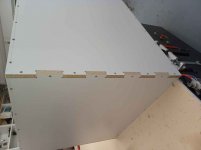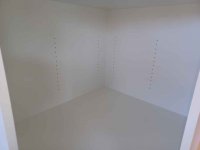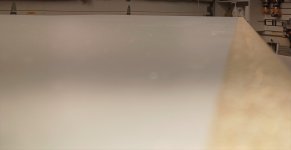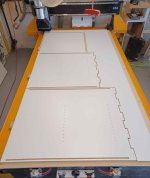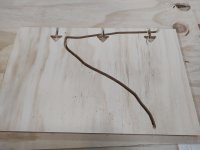Figured I would post a few pics since switching over to stop dado cabinet construction and ditching the dowels life went from good to great. The only issue with stop dados is needing to flip sometimes and a little extra work at the computer but thats getting better. My basic box design doesn't need any flipping but this corner cabinet would have needed it so to avoid the flip I decided to tab the back corner. Loved it, it worked perfectly everything stays self supported and the tabs get screwed from both sides so it pulls the joint nice and tight and no flipping for doing rabbits. Everything just fits together so nicely and you end up with super flush edges and square without any fussing.
You are using an out of date browser. It may not display this or other websites correctly.
You should upgrade or use an alternative browser.
You should upgrade or use an alternative browser.
Stop dado and tab cabinet
- Thread starter afish
- Start date
Michael Kellough
Member
Do you use the same bit for drilling holes and cutting the perimeter and slots?
The interlocking tabs are very cool. Wonder if they would be equally effective with nailing instead of screws. You could quickly shoot two nails at opposing angle to resist withdrawal.
The interlocking tabs are very cool. Wonder if they would be equally effective with nailing instead of screws. You could quickly shoot two nails at opposing angle to resist withdrawal.
sorry missed the second half of your post. I have used staples in the past and for plywood they work "good" not as good as screws but with melamine screws are waaaay better. The staples work but require more clamping to pull the joints tight first. I use roo glue on the melamine and its pretty thick stuff so if you get a little heavy handed on the glue a staple wont suck the joint closed without clamping first. It takes a little longer clamping unclamping but the staples are cheaper. I sometimes staple smaller boxes but that corner unit is pretty big as one side is 30" deep. The other nice thing about the stop dado is it exposes a lot of raw wood for the glue I dont need the roo glue but I like it as it dries clear and even if you dont clean it all up you cant tell unlike the brown tightbond. once dried its plenty strong.
- Joined
- Oct 16, 2015
- Messages
- 5,559
That's an interesting way to go about it. I like the solidness of the whole assembly, that way. Yes, screws would be way better for that, staples just won't pull a joint closed. They hit so quick, with no mass to exert on the gap. They will actually hold a joint apart, rather than close it up.
Roo Glue is some fantastic stuff. It sticks like crazy, to the point of causing damage if you need it back apart. It's funny stuff though. It is thicker than yellow glue as far as runny, but then when you touch it? Like nothing is there. It feels more like hand lotion than glue.
We do a 45 degree panel across the back of corner cabinets, just to stay away from the sharp corner. The walls are never square, so this keeps from having a point back there in the taped joint of the drywall.
It would add an additional tool change, but you wouldn't believe how much faster the machine can run if you do the perimeter cut-out with a 3/8" bit, assuming it has the power to increase the feed rate that much?
The company where I work, stepped up to a full-sized (5 x 12) CNC machine, from the old point-to- point machine, right after I started there. (18 years ago) They ran it for years with 1/4" bits for the cut-out. The move to 3/8" was huge. That thing moves at a pace that is simply amazing. Of course, this is in an industrial shop where speed is king, making hundreds of parts.
Roo Glue is some fantastic stuff. It sticks like crazy, to the point of causing damage if you need it back apart. It's funny stuff though. It is thicker than yellow glue as far as runny, but then when you touch it? Like nothing is there. It feels more like hand lotion than glue.
We do a 45 degree panel across the back of corner cabinets, just to stay away from the sharp corner. The walls are never square, so this keeps from having a point back there in the taped joint of the drywall.
It would add an additional tool change, but you wouldn't believe how much faster the machine can run if you do the perimeter cut-out with a 3/8" bit, assuming it has the power to increase the feed rate that much?
The company where I work, stepped up to a full-sized (5 x 12) CNC machine, from the old point-to- point machine, right after I started there. (18 years ago) They ran it for years with 1/4" bits for the cut-out. The move to 3/8" was huge. That thing moves at a pace that is simply amazing. Of course, this is in an industrial shop where speed is king, making hundreds of parts.
my machine is plenty powerful enough to run the 3/8 I upgraded everything on it including full servos. The problem comes with the vacuum table. since im not on a 3 phase power its hard to get a big vacuum pump. If I really try to push it I end up moving parts and that sucks when it happens. so I tend to cut slower then needed just to be safe. I do use a 3/8 bit if I am leaving a skin on the bottom which I will do on cabinet liner. If Im cutting smaller parts and need to leave tabs to keep parts from shifting when the bit comes up and goes back down it will leave a small chip on bottom side. sometimes it doesnt matter but sometimes it does so I cut that with 3/8 and leave a skin that way when I flip the sheet over I can run a 1/4 down cutting spiral with bearing to get the cleanest cuts.
Im loving those finger/tab joints. its super strong and makes everything just line up with no effort. I built a 6 foot long post with about 200 tabs and it went together like a quality zipper. I also made some clothes hampers and used exposed dominos alternating to lock the joint. I thought I had posted pics on FOG but I searched and couldnt find it.
my joints are snug but still a slip fit but yea that roo glue is so thick it causes some hydrostatic pressure in the joint and makes it harder to close
Im loving those finger/tab joints. its super strong and makes everything just line up with no effort. I built a 6 foot long post with about 200 tabs and it went together like a quality zipper. I also made some clothes hampers and used exposed dominos alternating to lock the joint. I thought I had posted pics on FOG but I searched and couldnt find it.
my joints are snug but still a slip fit but yea that roo glue is so thick it causes some hydrostatic pressure in the joint and makes it harder to close
- Joined
- Oct 16, 2015
- Messages
- 5,559
Even with the biggest, most ridiculous, vacuum pumps, it can still happen. As I mentioned in my post about the reception desk I am currently working on, the main CNC guy was out sick the day I started it. That meant I had to run the parts myself. I normally don't, they are done by someone else and waiting on me to get to them. That run was 12 sheets of 3/4" ply. I was nearly done, only a couple of sheets left. It was the sub-top parts for the Corian top. I loaded the sheet, started it up and went around to the vertical panel saw behind it to cut up some of the drop from the other sheets into usable rectangles. I came back to this. Apparently, there was some tension in the sheet and as that got released, it turned into a potato chip. The curl pulled away from the vacuum table, the crazy squiggle came from the piece getting lose. It's usually when there is a bunch of small pieces that things get pushed around, if it's going to happen.
Attachments
anything under about 2x2 I will typically leave a onion skin or tabs just to b e safe. with the price of materials these days it hurts when you F up. The other thing I'll do is if I dont want to deal with the tabs is Ill leave the last pass thickness around .020 that way there is very little lateral force on the part. Its un nerving for me to leave the machine. Thats usually when things go wrong for me. what kind of IPM are you running ? I ran some cabinet liner today with 3/8 in the 400 to 450 range. Thats pretty fast for me at that speed things go wrong quickly if they do go wrong.
- Joined
- Oct 16, 2015
- Messages
- 5,559
That is the cut-off end of what was a much larger piece. I cut it off to save the rest, which was over 60" originally. That is why I was so surprised when it moved. We regularly cut parts that are pretty small. Those are generally melamine coated particle board, small things like drawer parts and nailers get done near the end of the run of cabinet parts.
It worked out ok. I just moved that bad part to the last sheet, which had space for it already.
As far as IPM, I'm not sure. The software takes care of speeds/feeds initially. Of course, it can be slowed down on the control panel, by the operator, but for ply it never needs that.
We never do tabs, once in a while onion-skin with cases where it might be an issue, but the vacuum table is very strong, most things just stick there and take it.
The main CNC is effectively automatic. It has an in-feed crane that loads the sheets, the gantry itself pulls the next sheet onto the cutting area, an out-feed conveyor belt pulls the parts away. They stop at the end by an eye (sensor). As long as someone keeps taking the parts away, it can keep going, by itself, until it gets to the end of the run.
It worked out ok. I just moved that bad part to the last sheet, which had space for it already.
As far as IPM, I'm not sure. The software takes care of speeds/feeds initially. Of course, it can be slowed down on the control panel, by the operator, but for ply it never needs that.
We never do tabs, once in a while onion-skin with cases where it might be an issue, but the vacuum table is very strong, most things just stick there and take it.
The main CNC is effectively automatic. It has an in-feed crane that loads the sheets, the gantry itself pulls the next sheet onto the cutting area, an out-feed conveyor belt pulls the parts away. They stop at the end by an eye (sensor). As long as someone keeps taking the parts away, it can keep going, by itself, until it gets to the end of the run.
Similar threads
- Replies
- 20
- Views
- 2K
- Replies
- 3
- Views
- 989
- Replies
- 14
- Views
- 3K

